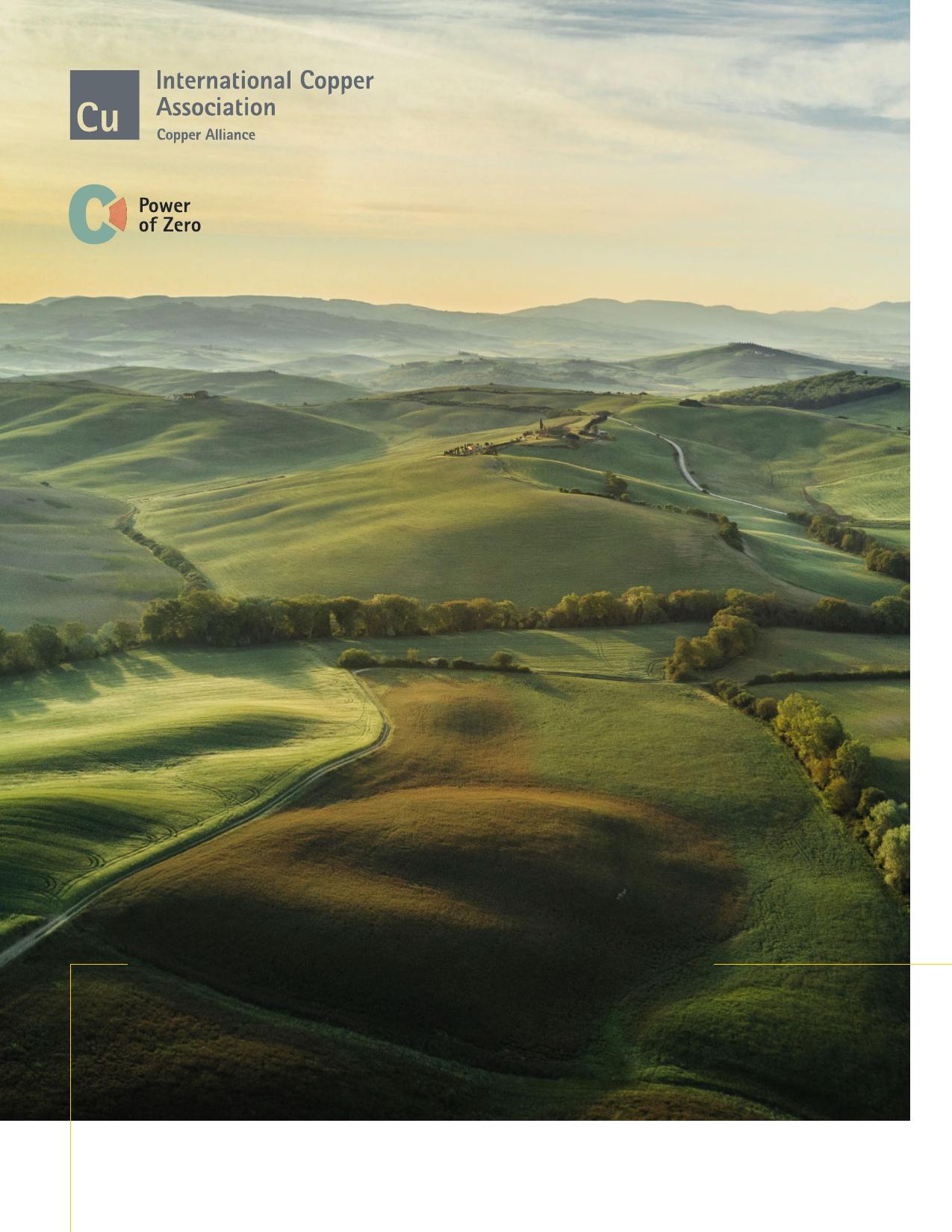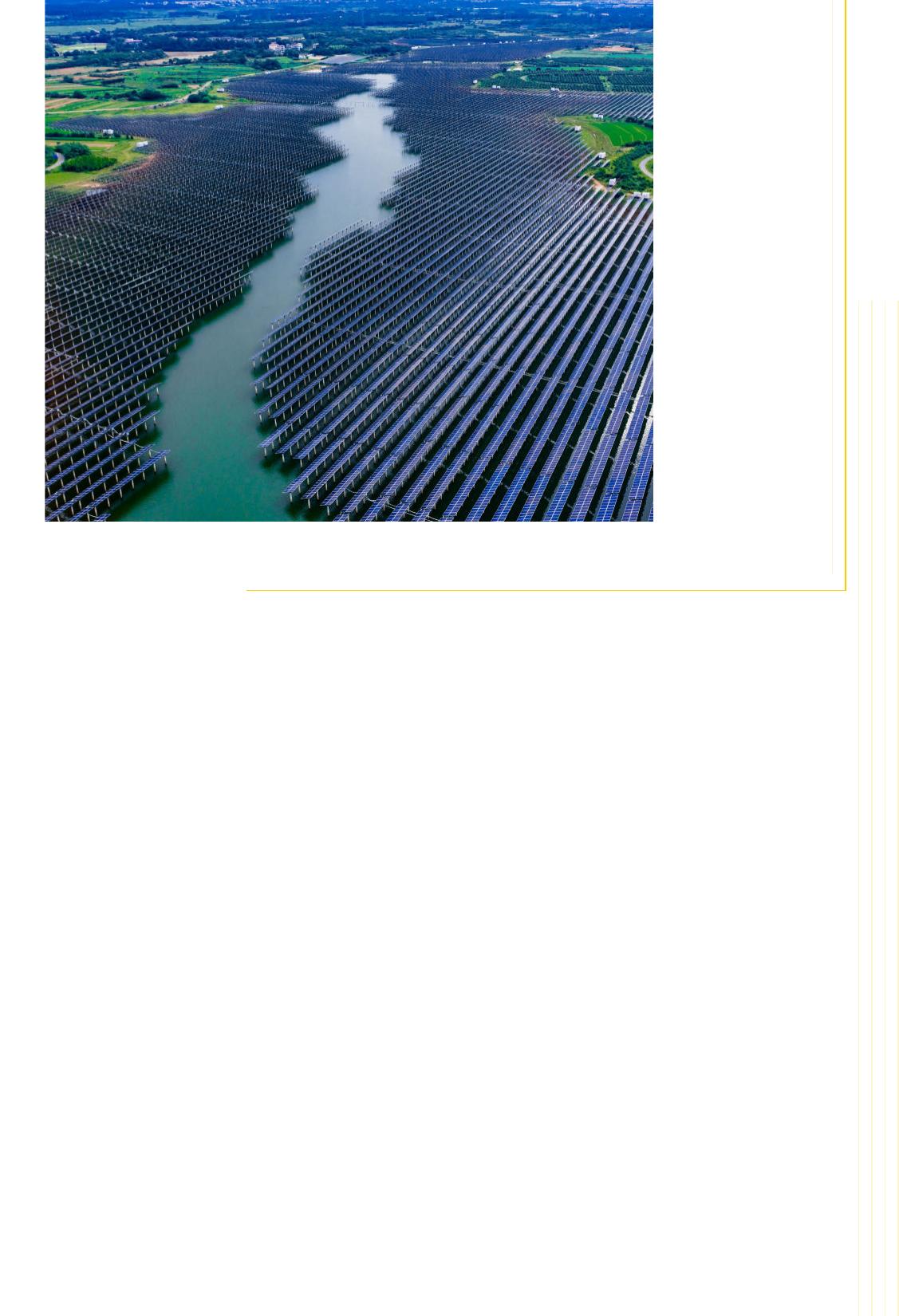COPPER—THEPATHWAYTONETZEROMarch2023GlossaryAbbreviationsADAT:assetdecarbonizationassessmenttoolCAPEX:capitalexpendituresESG:environmental,social,governanceEV:electricvehicleGHG:greenhousegasemissionsIACS:InternationalAnnealedCopperStandardICA:InternationalCopperAssociationICMM:InternationalCouncilonMiningandMetalsICSG:InternationalCopperStudyGroupIEA:InternationalEnergyAgencyIFC:InternationalFinanceCorporationLCA:lifecycleassessmentLME:LondonMetalExchangeMACC:MarginalAbatementCostCurveOECD:OrganizationforEconomicCo-operationandDevelopmentOPEX:operationalexpensesPPA:PowerPurchaseAgreementPV:photovoltaicUN:UnitedNationsTerminologyAlternativefuels:e-fuels,biogas,biomethane,hydrogenandammoniaproducedwithnon-fossilenergy,hydrotreatedvegetableoil(HVO),biocharArchetypes:shortfor“archetypicalproductionprocesses,”combinationsofmajorproductionstagesandtechnologiesofcopperproductionCopperindustry:includescoppermines,smelters,refiners,recyclingfacilitiesandfabricatorsofsemi-finishedproductsfromcopperandcopperalloysCopperproducers:includescoppermines,smelters,refinersandrecyclingfacilitiesCopperproduction:theproductionofrefinedcopperfromcopperoreextractedfromminesorcopperscrapgeneratedthroughrecyclingElectricitymix:themixofenergysourcesusedtoproduceelectricityinaparticularcountryorregionEnd-of-liferecyclingrate:theshareofcopper-containingproductsreachingtheendoftheirlifecyclethatiscollected,separatedandprocessedintocopperscrapEnd-of-liferecyclinginputrate:theshareofrefinedcopperproductionoriginatingfromoldscrapEnergyorcleanenergytransition:thetransitionfromaneconomybasedonfossilfuelstoaclimateneutraloneDecarbonizedelectricity:electricitygeneratedfromfossil-freeenergysourcesMill-headgrade:themetalcontentofminedcopperoregoingintoamillforprocessingNewscrap:scraporiginatingfromwasteinthefabricationofsemi-finishedandend-useproductsOldscrap:scraporiginatingfromtherecyclingofcopper-containingproductsreachingendoflifePrimarycoppersources:copperorefromminingoperationsRecyclinginputrate:theshareofrefinedcopperproductionoriginatingfromrecycledmaterial,botholdandnewscrapRefinedcopper:copperwithatleast99.99percentpurity,whichresultsfromasmeltingandrefiningprocessScope1emissions:directGHGemissionsfromownedorcontrolledsourcesScope2emissions:indirectGHGemissionsassociatedwiththepurchaseofelectricity,steam,heatorcoolingScope3emissions:allindirectGHGemissionsnotincludedinScope2thatoccurinthevaluechainofacompany,bothupstreamanddownstreamSecondarycoppersources:copperscrapfromrecyclingSemi-finishedproducts:productsfabricatedfromrefinedcopper,sometimesalloyedwithothermetals,intheformofwire,rod,tube,sheet,plate,strip,castings,powderorothershapes.Theyarefurthertransformedbydownstreamindustriestoproducecopper-containingend-useproducts.Copper—ThePathwaytoNetZerocopperalliance.orgContentsIntroduction..............................................................2Executivesummary...............................................4Section1—Theroleofcopperanditsindustry....................................................6Copperuseinsociety........................................6Copperintheenergytransition...................7Copperuseinnumbers....................................8Thecopperindustry...........................................9Thecopperproductionprocess.................10Section2—Thecopperindustrydecarbonizationchallenges........................12GHGemissionsofcopperproductiontoday.............................................12Baselineforcomputingtheabatementpotential........................................15No-actionscenario..........................................15Definingthebaseline......................................17AbatingScope1and2emissions.............18AbatingScope3emissions..........................23Requiredmeansforreachingthedecarbonizationtarget...........................26ThedecarbonizationoftheChinesecopperindustry...............................28Section3—FrameworkconditionsfortheICAdecarbonizationgoal...........30Section4—Thewayforward......................32Measuringprogress........................................32Decarbonizationandresponsibleproduction..........................................................33UpdatingthePathwaytoNetZero...........33Developingpartnerships...............................33Annex1:Archetypicalproductionprocesses.................................................................34Annex2:Copperintheenergytransition..................................................35Annex3:Copperproduction..........................36Annex4:Copperproductionandtrade....38Annex5:Copperrecycling.............................39References..............................................................40Developingaglobalroadmapforthecopperindustrytoreducecarbonemissionsoverthenext30yearsposesacriticalchallenge.Itrequiresrigorousdatacollection,in-depthanalysisandmodelingtochartpotentialpathwaysforacleanenergytransitionacrossthesector.Anyforecastoftheindustry’scapacitytoreducecarbonemissions—andstrategiesforachievingtargets—mustaddressissuesrelatedtoproduction,changesintechnologyandglobaltrends.ICAfirstassessedthecurrentworldwidegreenhousegas(GHG)emissionsofthecopperindustrywiththesupportofenvironmentalsustainabilityconsultancyQuantis.AnalystscollectedemissionsdatafromICAmembersforeachmajorstepoftheproductionprocessusing2018asthebaseline,astheCOVIDpandemicandlockdownsthatfollowedlikelyskewedthefiguresfromthesubsequentyears.TheyincorporateddataonlocalelectricitygridemissionfactorspublishedbytheInternationalEnergyAgency(IEA)andthemodelofglobalcopperstocksandflowsbuiltbytheFraunhoferInstitutetoassessthe2018carbonfootprintoftheentirecopperindustry.TheyalsogathereddataonScope3GHGemissionsfrompurchasedgoodsandservices,fuel-andenergy-relatedactivities,transportupstreamanddownstreaminthevaluechain,operationalwasteandend-of-lifetreatmentofsoldproducts,sixcategoriesthatrepresentthebulkofScope3emissionsforcopperproducers.Onceperformed,thiscarbonfootprintassessmentwasdevelopedintoanemissionsprofilefor14typesofproductionprocesses,whichincludevariousstagesandtechnologies(“archetypes”—seeAnnex1)andcovercoppermining,refining,smeltingandcopperrecycling.Theproductionstage“mining,”forexample,includesopenpitmining,undergroundminingwithroomandpillartechnology,undergroundminingwithblockcavingtechnology,andundergroundminingwithlongholestoping.Theanalysisthenassessedoptionstoreducecopperproduction’sGHGemissionswithinfourabatementcategories:alternativefuels,decarbonizedelectricity,equipmentelectrificationandenergy-efficiencygains.Nooffsetswereconsideredinthisassessment.Thisanalysisconsidersemissionabatementoptionsforeacharchetype,theirpotentialtoloweremissionsandtheirtotalcostIntroductionTheInternationalCopperAssociation(ICA)anditsmembershavedevelopedthisroadmap,Copper—ThePathwaytoNetZero(furtherthePathway),throughapragmaticanalyticalapproachthatleveragestheknowledgeofcopper-producingcompaniesaswellaspublicdatasetsofindustryexpertssuchasMineSpans.ICAmembersrepresentapproximately50percentoftheworldwiderefinedcopperproductionandareuniquelypositionedtocollectandanalyzedatarelatedtocarbonemissions.ThisdocumentoutlinesICAmembers’commitmenttodecarbonizingtheproductionofcopper—akeyrawmaterialcriticaltotheenergytransition—andpresentsstrategiesforbringingthecarbonfootprintascloseaspossibletonetzeroby2050forcoppermining,smelting,refiningandrecycling.3Copper—ThePathwaytoNetZerocopperalliance.orgofownership(TCO)toestablishtheUnconstrainedMarginalAbatementCostCurve(MACC).DrawingontheUnconstrainedMACCthestudythencalculatesaConstrainedMACCforeachregionoftheworldthatconsiderstheelectricitygridemissionintensity,availabilityofeachabatementoptionanditslongtermTCO.ThisanalysisestablishesapathwaytoreduceScope1and2GHGemissionsforeacharchetypeineachregionandpresents:•Themosteffectiveemissionabatementoptions•Therecommendedtimelineandsequencesforimplementingtheseoptions,withtwointermediatemilestonesfor2030and2040andathirdtargetby2050•ThefinancialinvestmentrequiredtoreachthesetargetsBycombiningtheConstrainedMACCsofallregionsintheworld,theanalysisdevelopsaglobaloverviewthatdemonstrates:•TheScope1and2GHGemissionsabatementpotentialby2030,2040and2050•Theportfoliooftechnologieswiththepotentialtoachievethisreduction•AfirstestimateofthefinancialinvestmentsatthegloballevelrequiredtoimplementsuchtechnologiesTheanalysisestimatesScope1and2GHGemissionsabatementpotentialthroughabottom-upanalysisdrawingoninformationaboutcopperproductionassets,reportedminedevelopmentprojectsandcountry-by-countryforecastsontheevolutionofgridemissionfactors.Bycontrast,itprovidesatop-downanalysisofScope3GHGemissionsthatidentifiesemissionabatementoptionsforeachoftheScope3categoriesitexamines.Mostoftheseoptionswillrequirepartnershipsbetweencopperproducers,suppliersandcustomersoftheindustry.Thisdetailedanalysisbyservesasabasisforadecarbonizationpathwaybytheglobalcopperindustry.ThePathwayoutlinesthecommitmentsICAmemberswillundertaketoworktowardthegoalofnet-zeroGHGemissionsby2050acrossthesector.ThePathwayis,however,notintendedtobeprescriptiveonhowtodecarbonizespecificcopperproductionsitesasindividualproducersknowbestwhichdecarbonizationmeasurestoimplementacrosstheirassets.Rather,itanalyzesavailabledecarbonizationoptionstoproposeageneraltrajectorytowardnet-zeroemissionsfortheglobalcopperproductionindustry.ThePathwayalsodeterminesthestrategiesandconditionsrequired,includingfinancialinvestments,equipment,technologiesandaccesstodecarbonizedelectricity.Ithighlightsthesector-wideeffortsnecessarytoreachclimate-neutralcopperproductionby2050giventhelimitationsthecurrentportfolioofdecarbonizationtechnologiespose.We,themembersofICA,expecttheGHGemissions-reductiontrajectoriesofindividualICAmemberstovarybecauseofthesignificantdifferencesthatexistbetweenthegeographicalregionsinwhichcopperisproduced,e.g.,intermsoftheprojecteddevelopmentofaffordableandreliablerenewableenergysources.Ourcollectivetrajectoryis,therefore,indicativefortheindustryasawhole,andindividualmembersremainresponsibleforsettingtheirownintermediateGHGemissionsreductiontargetstowardnetzero.Anyforecastoftheindustry’scapacitytoreducecarbonemissions—andstrategiesforachievingtargets—mustaddressissuesrelatedtoproduction,changesintechnologyandglobaltrends.ExecutiveSummaryCopperisessentialforavastarrayofdecarbonizingtechnologies.Whentakentogether,thesetechnologieshavethepotentialtoaccountfortwo-thirdsofglobalgreenhousegasemissions’abatementby2050.Theproductionofthiscrucialrawmaterialaccountsforaround0.2percentofworldwidegreenhousegasemissions(97Mtin2018).Thecopperindustryisactivelyworkingtoreducetheseemissions.5Copper—ThePathwaytoNetZerocopperalliance.orgThemembersoftheInternationalCopperAssociation(ICA),theleadingadvocateforthecopperindustryworldwide,committoagoalofreachingnetzeroScope1and2greenhousegasemissionsby2050andtoactivelyengagewiththeirvaluechainpartnerstobringScope3emissionsascloseaspossibletonetzeroby2050.Furthermore,ICAmembershavesetintermediatedecarbonizationambitionsfortheyears2030and2040,forScope1,2and3emissions,whichareoutlinedinthisdocument,Copper—ThePathwaytoNetZero.Thiscollectiveengagementistheresultofaglobalin-depth,robustanalysisperformedbyICAanditsmembers,andbasedonacomprehensivesetoffactsandsoundhypotheses.Copper—ThePathwaytoNetZerodefinesapragmaticapproachtodecarbonizingcopperproductionbyoutliningwhichdecarbonizationoptionscanbeactivatedbywhen,withwhatimpactongreenhousegasemissionsandatwhatcost.Thisdecarbonizationpathwaymustbeaccomplishedinthecontextofadoublingofcopperdemand—from25milliontonnesin2020to50milliontonnesin2050—drivenbycriticaldecarbonizationtechnologiessuchaswindturbines,photovoltaicpanels,heatpumps,electricvehiclesandenergy-efficientequipment.ThisPathwaytoNetZerodemonstratesthecommitmentofICAmemberstoactonclimatechange.Copperproducersarealreadytakingactiontoreducetheircarbonfootprintthroughinitiativessuchasequipmentelectrification,decarbonizationofelectricity,useofalternativefuelsandenergyefficiencymeasures.ICAmemberscommittodeployingtheseandadditionaldecarbonizingmeasuresinaresponsibleandsustainablemanner,notingtheincreasingacceptanceofTheCopperMark®,theworld’sleadingthird-partyassuranceframeworkforcopperproduction.ICAmembersareworkingonamechanismtoensuretransparentandregularreportingoftheirprogressindecarbonizingcopperproduction,throughacoherentandalignedmethodologyformeasuringcarbonfootprint.Inaddition,ThePathwaytoNetZerowillberegularlyupdatedtointegratechangesintechnologyandexternalvariables,e.g.,decarbonizationofthepowergrid.SuccessindecarbonizationdependsnotonlyontheeffortsofcopperproducersbutalsoonthefulfilmentofcriticalframeworkconditionsonwhichICAwillproactivelyworkwithkeystakeholders.•Decarbonizationtechnologiessuchasgreenhydrogenandbatteryelectricminingvehiclesneedtobeavailableatscale.•Decarbonizedelectricityneedstobesuppliedinsufficientquantitiesandataffordableprices.•Collectionratesofcopper-containingproductsattheirendoflifemustbeimprovedtoincreasethecontributionofrecyclingtodecarbonization.•Flexibleandaffordablefinancingmustbeavailableforcapacityincreasesandinnovation,whileapoolofskilledstaffisneededtodrivethetransition.•Effectiveandefficientregulatoryframeworksneedtobeinplacetoallowfortransparentcarbonpricing,reasonablepermittingdeadlines,accesstopublicfundsforinnovationindecarbonization,stablelicensingandroyaltyschemes,andconsistentchemicalandproductregulations.ICAmemberslookforwardtoactivelyengagingwithsuppliers,customers,communitiesandpolicymakerstoachievethedecarbonizationofcopperproductionby2050andtoprovideakeyrawmaterial,inincreasingquantities,toenablethedecarbonizationofmanysectorsoftheeconomy.Copper—ThePathwaytoNetZerodefinesapragmaticapproachtodecarbonizingcopperproduction.TheRoleofCopperandItsIndustryWhydoessocietyneedcopper,todayandinthefuture,andhowisitproduced?Thissectionprovidesabriefoverviewoftheroleofcopperanditsindustryinoursociety.CopperUseinSocietyCopperhasbeeninuseforatleast10,000yearsandcontinuestoservesociety’sneeds.Ithasuniquephysicalandchemicalproperties,includingelectricalconductivity,thermalconductivity,corrosionresistance,machinabilityandcastability[1,p.12–20].Thesehigh-performancepropertiesmakecopperanessentialmaterialinawidevarietyofapplicationsnecessaryforqualityoflifeandsustainableeconomicgrowth.In2020,about70percentofcoppersaleswasdestinedforelectricalapplications[2].Asthebestmetallicelectricalconductorafterpreciousmetals,coppersetsthestandardofelectricalconductivity(InternationalAnnealedCopperStandard–IACS)[3].Itcanbefoundthroughouttheentireelectricitysystem—frompowergeneration,overtransmissionanddistributionnetworks,toelectricityenduse.Copperisrecognizedasakeymaterialforcreatinganenergyefficient,reliableandsafepowersupplytocommunitiesaroundtheworld.BUILDINGS&INDUSTRYElectricalInstallationsAppliancesSolarHeatingAirConditioningHeatingWaterandGasMotorsELECTRICITYSYSTEMRenewableGenerationTransmissionandDistributionSystemSubmarineandUndergroundCableGridStorageTRANSPORTRailways(Catenary)AutomotiveHarnessAutomotiveBatteriesElectricCarMotorsMISCELLANEOUSTelecommunicationsElectronicAppliancesFarmingandAgricultureAquacultureMarineApplicationsArchitectureInteriorDesignCopperhasuniquephysicalandchemicalproperties,includingelectricalconductivity,thermalconductivity,corrosionresistance,machinabilityandcastability.SECTION1Figure1—OverviewofCopperUses7Copper—ThePathwaytoNetZerocopperalliance.orgCOPPERINTHEENERGYTRANSITIONCopper’ssuperiorelectricalconductivitymakesitanessentialmaterialfortheenergytransitiontocarbonneutrality.Thetransitionreliestoalargeextentonrenewablepowergeneration(e.g.,wind,solarphotovoltaic)andtheelectrificationofenergyenduse(e.g.,heatpumps,electricvehicles),allofwhichusesubstantialamountsofcopper(seeAnnex2formoredetails).Copperenablesamoreenergy-efficientelectricitysystem,triggeringcarbonemissionsavingsatanegativecostintheshorttermandreducingtheneedforrenewableenergygenerationcapacityinthelongerterm.Inshort,copperuseinavastarrayoftechnologicalsolutionshasthecollectivepotentialtoreduceworldwideGHGemissionsbytwo-thirds.Figure2—CopperintheEnergyTransitionBatteriesSolarPanelsWindMillsBuildingAutomationHeatPumpsWastewaterHeatRecoveryElectro-ProcessingMotorSystemsElectricVehiclesChargingInfrastructureInterconnectors,SubseaGrid,TransformersCOPPERUSEINNUMBERSGlobalannualrefinedcopperusagehasbeenconsistentlyrisingfrom0.5millionmetrictonnesin1900toabout2millionmetrictonnesafterWorldWarIIto25milliontonnes2020.Thiscorrespondstoacompoundannualgrowthrateof3.4percentoverthis120-yearperiod.Thisincreaseisdueinparttothegrowthinglobalpopulationaswellasgrowthincopperusagepercapita.In1950,theaverageannualrefinedcopperusagepercapitawas1.15kg.By2020,thisnumberwascloserto3.25kg.Growthincopperdemanddiffersgreatlyacrossregions(seeFigure5).Forthepast25years,growthcanbemainlyattributedtotheAsianmarket,wheredemandhasexpandedeight-foldoverthepastfourdecades,largelydrivenbyindustrialexpansioninChina(source:ICSGCopperFactbook).Asaresultoftheenergytransition,populationgrowthandeconomicdevelopment,theannualrefinedcopperdemandisexpectedtodoubleby2050comparedto2020,asshowninFigure6.Ifmeasuresaretakentorestrictglobaltemperatureriseto1.5°C,demandforrefinedcopperby2050couldbeevenhigher,increasingto57milliontonnesOtherrecentanalyses[16,page90]estimatecopperdemandwilldoubleevenbefore2050.Thisforecastassumesastrongregulatorypushupto2030andanaggressiverolloutofrenewablesandelectrificationintheverynearterm.ThePathwaydevelopsabottom-up,forward-lookingdemandmodelthataccountsforthetimeconstraintsrelatedtothedeploymentofdecarbonizationtechnologies.Figure3—WorldRefinedCopperUsage1900–2020,PerThousandMetricTonnesofCopper(Source:ICSG)Figure4—WorldRefinedCopperUsagePerCapita1950–2020(theamountofcopperusedbyindustrydividedbythetotalpopulationexcludingcopperusedinfinishedproductsperperson)(Sources:ICSGandU.S.CensusBureau)Figure5—RefinedCopperUsagebyRegion,1960Versus2020(Source:ICSG)WorldRefinedCopperUsage:1900-2020WorldRefinedCopperUsageperCapita:1950-202019602020Europe57%NorthAmerica30%Asia10%Oceana2%LatinAmerica1%Africa.5%Europe15%NorthAmerica9%Asia74%Oceana.02%LatinAmerica1%Africa1%9Copper—ThePathwaytoNetZerocopperalliance.orgTheCopperIndustryCopperisproducedfromtwosources:copperore—alsocalledprimarycoppersources—andcopper-containingscrap—alsocalledsecondarycoppersources.Bothsourcesareusuallycombinedbycopperproducersandgeneratethesamequalityofcoppermetal,ascoppercanberecycledinfinitelywithoutlossofproperties.Thecopperindustryincludescoppermines,smelters,refiners,recyclingfacilitiesandfabricatorsofsemi-finishedproductsfromcopperandcopperalloys,suchastubes,wirerodsandbars.Copperisanimportantcontributortothenationaleconomiesofmature,newlydevelopedanddevelopingcountries.Mining,processing,recyclingandthetransformationofmetalintoamultitudeofproductscreatesjobsandgenerateswealth.Nearlyonemillionpeopleworkdirectlyfortheglobalcopperindustry,fromminingtofabrication[4].Atleastonemoremillionpeopleareemployedindirectly.605550454035302520151050BaseCaseRefinedCopperDemandbyEndUse,2020-2050,Mt6.28.39.710.79.811.415.119.14.46.88.08.72.63.25.76.42.025.03.833.537.84.743.347.45.250.157.0BuildingandConstructionElectricalandElectronicIndustrialMachineryandEquipmentTransportationConsumerandGeneralProducts1.5Deg.Preliminary20F30F20402050Figure6—TheExpectedRiseinAnnualRefinedCopperDemandBetween2020and2050(Source:MineSpansCopperDemandModelQ32021)+3.0%p.a.+2.6%p.a.+1.5%p.a.Mining,processing,recyclingandthetransformationofmetalintoamultitudeofproductscreatesjobsandgenerateswealth.THECOPPERPRODUCTIONPROCESSProductionfromprimarysourcesstartswiththeextractionofcopper-bearingoresfromopen-pitorundergroundmines.Theorestypicallycontainbetween0.25and1percentofpurecopper.Subsequently,twodifferentproductionroutesexist(pyrometallurgicalandhydrometallurgical),dependingonthecharacteristicsoftherawmaterial—sulfideoroxideores.Productionfromsecondarysourcesisfedbycopperscraporiginatingeitherfromsemi-finishedorfinishedproductsmanufacturingwaste(“newscrap”),orfromcopper-containingproductsreachingtheendoftheirlife(“oldscrap”).Afterinitialtreatment,whichusuallyincludessortingandshredding,thecopperscrapentersthepyrometallurgicalproductionprocessatdifferentstages.ThethreeproductionroutestorefinedcopperareshowninFigure7andmoredetailsoncopperproductionprocessescanbefoundinAnnex3.Worthunderlyingisthe“metalcarrier”characterofcopper:itsproductiongeneratesarangeofimportantmetallicbyproducts—includinggold,silver,cobalt,molybdenum,platinumgroupmetals,selenium,tellurium—aswellasmorecomplexbyproductssuchassulfuricacidandironsilicate.Copper’sinfiniterecyclabilityisamajoradvantage.About80percentofcopperisusedinanunalloyedform[5],facilitatingtherecyclingprocess.Evenforalloyedcopperorcoppercontainingothermaterials,recyclingwithoutdowngradingitsqualityisstillpossibleandefficient.Thismeanstheunwantedelementscanberemovedtorecoverthecopperinitspurestate,readytobere-usedinanykindofapplication.Becauseofitshighdegreeofrecyclability,thecopperinuseinvariousapplicationsisnotlostbutcanbeconsideredanadditionalsourceofcopperforfurtheruse,oftenreferredtoassociety’s“urbanmine.”Sixteenpercentofcopperdemandcanbefulfilledthroughtherecyclingofcopperscrapfromend-of-lifeproducts(10-yearaveragein2018,seeFigure8).Thisfigureislimitedbecausecopperdemandhasbeenincreasingsubstantiallyovertheyears,thisresultsinasmallervolumeofcopper-containingproductsreachingendoflifeascomparedtotheamountofnewcopper-containingproductsenteringthemarket.Another16percentofcopperdemandcanbefulfilledthroughtherecyclingoffabricationscrap.Addingupbothnumbersshowsatotalrecyclinginputrateof32percent[5,p.59].Twodifferentproductionroutesexist,dependingonthecharacteristicsoftherawmaterial—sulfideoroxideores.Figure7—TheThreeProductionProcessesofRefinedCopper.COPPERORECOPPERSCRAPHYDROMETALLURGICALPROCESSLeaching+SolventExtraction+StrippingCrushing+Milling+Flotation+ShippingUseincombinationwithprimarycoppersources(ore)FurtherprocessinginasecondarycoppersmelterSorting+Shredding(andotherpre-treatment)ElectrowinningFormulationofcopperconcentrateConverterfurnaceAnodefurnaceAnodecastingwheelAnodeRefineryFlashsmeltingfurnaceConverterfurnaceAnodefurnaceAnodecastingwheelAnodeRefineryFlashsmeltingfurnacePYROMETALLURGICALPROCESS11Copper—ThePathwaytoNetZerocopperalliance.orgAlthoughtheend-of-liferecyclingrateneedstogrowtomeetincreasingdemandandconserveexistingresources,recycledcopperalonewillnotmeetgrowingdemand.Thefirstre-useofextractedcoppercanbedecadeslater—alongaveragelifetimeisbeneficialforreducingtheenvironmentalimpactofproductionbuthasanegativeeffectoncopperavailabilityfromsecondarysources.TheWorldBankGroupcalculatedthatevena100percentend-of-liferecyclingratewouldonlyreducethedemandforcopperfromprimarysourcesby26percentby2050[6].Moreover,noprocessis100percentefficient,andlossesincollection,separationandre-processingofcopperscrapwillalwaysexist.Forthisreason,copperproducedfrommineraloreswillstillberequired,alongwithrecycledcopperscrap,tofulfillthegrowingneeds.MoredetailedinformationoncopperproductionandoninternationaltradeflowsofcopperconcentrateandrefinedcopperareshowninAnnex4.Figure8—IndustryGlobalFlowofCopperFabricationofend-useproductsSmeltingandRefiningMiningFabricationofsemisStockofCopperinUse16%ofcopperdemand(pre-consumerscrap)16%ofcopperdemand(end-of-life/post-consumerscrap)TheCopperIndustryDecarbonizationChallengesICAmembersrecognizetheirglobalstewardshipresponsibilityinembracingsustainabilityobjectives.Asanillustration,in2020,TheCopperMark®,anindependentthird-partyassuranceframework,waslaunchedwiththesupportofICA.TheCopperMarkisdesignedtoprovideallstakeholderswiththeconfidencethatcertifiedcopperproductionsitesoperateaccordingtointernationallyaccepted,responsibleindustrialpractices.Inthiswidercontextofsustainableproduction,ICAmembershavetakentheinitiativeofassessinghowcopperproductioncanbedecarbonized.Thissectionanalyzeshowthecopperindustrycandecarbonizeitsproductionprocesses.ItfirstdescribescurrentGHGemissionsandmodelstheevolutionofemissionsovertimebasedona“no-decarbonizationactions”(“no-action”)scenario.ThesectionthenpresentspathwaystoScope1andScope2emissionabatementandexploresstrategiestoreduceScope3emissions.Itaddressescapitalexpenditureandpartnershipswhichwillbecriticaltoemissionsreduction.ThesectionalsoreviewsoptionsforthedecarbonizationofthecopperindustryinChina,amajorplayerinthesectorinternationally.GHGEmissionsofCopperProductionTodayTheglobalcopperindustryemittedanestimated112milliontonnesofCO2e(Scopes1,2and3included)in2018.Theproductionofrefinedcoppergenerated97milliontonnes,about85percentoftotalemissions.Theremaining15milliontonneswereproducedduringthefabricationofsemi-finishedproductssuchaswire,tubes,sheets,castingsandpowders.GHGemissionsfromrefinedcopperproductionrepresent2percentofthetotalemissionsofthemetalsandminingsectorand0.2percentofthetotalglobalanthropogenicemissions.CoppergeneratesafractionoftheworldwideGHGemissionsandgreatlycontributestotheirreduction.Asexplainedintheprevioussection,copperisakeyrawmaterialforawidesetoftechnologiesthat,takentogether,enabletheabatementofabouttwothirdsoftheglobalGHGemissions.SECTION2CopperCO2OtherCO2Non-CO2Figure9—ShareofGHGEmissionsoftheCopperIndustry(Source:MineSpans,McKinseyEnergyInsights)1Scope1emissions:CO2:41.25%,CH4:30.39%,HFCs:2.21%andN2O:2.53%GWP:1002Metals,mining3Steel,aluminumandothermetalsTotalMan-MadeGHGEmissions,2018BasicMaterialsSectors257.1GTCO2e1TotalGlobalEmissionsOtherSectorsCopper0.2%11.4%22.6%7.2%14.3%3.4%26.1%3.1%7.1%4.6%AgricultureOil&gasTransportBuildingsOtherPowergenerationCoalminingCementOthermining&metals3~10.3%ofglobalGHGemissionsarefromthemetalsandminingsections13Copper—ThePathwaytoNetZerocopperalliance.orgThelargestportion—46percent—ofthe97milliontonnesofGHGemittedbycopperproducerswereScope2emissions,indirectemissionsassociatedwiththepurchaseofelectricity,steam,heatandcooling.Scope3emissions—otherindirectemissionsoutsideofScope2—represent31percentofGHGemissionsgeneratedbycopperproduction.Scope1emissions—directemissionsfromownedorcontrolledsources—represent23percentofGHGemissionsbytheindustry.ThisreportanalyzesScope3emissionsfromdataonsixcategoriesidentifiedasmaterialtocopperproduction:purchasedgoodsandservices,fuel-andenergy-relatedactivities,upstreamtransport,downstreamtransport,wastegeneratedinoperationsandend-of-lifetreatmentofsoldproducts.Itexcludesananalysisof“useofsoldproducts”duetoacurrentlackofreliabledata.Scopes1,2and3havebeendefinedatthefullcopperproductionlevel,meaningtherangeofprocessesfrommining,smelting,refiningtorecyclingdescribedinSection1,Figure7.Sincesomecopperproducersfocusonminingandtheproductionofconcentrates—andothersonsmeltingandrefiningonly—theclassificationbythesecompaniesoftheirGHGemissionsasScopes1,2and3willdifferfromthedefinitionusedhere.Figure10—Cost-BenefitAnalysisofCopperGHGEmissions25MILLIONTONNESOFREFINEDCOPPERUSEDPERYEAR0.2%OFGLOBALGHGEMISSIONSSOLUTIONSCONTRIBUTINGTOTHEABATEMENTOF2/3OFGLOBALGHGEMISSIONS97milliontonnesofGHGemissionsSolarpanelsWindmillsMotorsElectricvehiclesHeatpumpsSmartgridsCu,anessentialrawmaterial+itsbyproductsOfthese97milliontonnesofGHGemissions,70percentweregeneratedbyminingsites,23percentstemmedfromthesmeltingandrefiningstagesofproductionandtheremaining7percentoccurredinupstreamanddownstreamtransportandintheend-of-lifetreatmentofsoldproducts.In2018theGHGaverageemissionintensityofrefinedcopperproductionwas4.6tonnesofCO2epertonneofcopper.Thiscompareswith5.4tonnesofCO2ein1990,areductionof13.4percentoverthe28-yearperiod.Thisreductionstemmedfromanincreaseincopperproductionfromsecondarysources,changesintheelectricitymixandongoingmeasuresbycopperminerstoimprovetheenergyandemissionefficiencyofproduction.Figure11—GlobalScope1,Scope2andScope3CO2eEmissionsofCopperin2018(Source:Quantis)30.344.1GlobalScope1,2and3CopperCO2eEmissions,2018,MillionTonnesScope1Scope2Scope3MiningConcentrationHydroPyroTransportEoLTotal16.87.97.532.222.797.15.69.96.722.25.921.56.23.5.54.827.98.40.20.170%23%AverageGHGEmissionIntensityofRefinedCoppertCO2e/tCu19902000201520052018199520105.44.94.94.54.64.84.71.31.21.21.11.11.11.12.62.32.22.02.02.22.11.51.41.51.41.51.51.5Scope1Scope2Scope3Figure12—GHGEmissions–PastPerformance15Copper—ThePathwaytoNetZerocopperalliance.org15Copperproductionenablestheextractionofothermetalsthatarecriticalforsociety,themanufacturingofbyproducts(e.g.,sulfuricacidandironsilicates)andrecoveryofheatfromsmeltingforuseinotherapplicationslikedistrictheating.Theemissionsassociatedwithby-andco-generatedproductsamountedto19.3milliontonnesofCO2ein2018andareassumedasavoidedemissionselsewhere,asthoseproductsrepresentinganimportantshareofthosemarketsareincidentallyprovidedbythecopperindustry.BaselineforComputingtheAbatementPotentialNO-ACTIONSCENARIOTheproductionofrefinedcopperisexpectedtodoublebetween2020and2050,leadingtoanannualproductionof50milliontonnes,with10milliontonnesofthetotaloriginatingfromcopperscrap.Overthisperiod,twomajorfactorswillaffecttheCO2eintensityofcopperproduction:1)thedeclineofthemill-headgradeofcopperorewillcontinuetodriveupemissions,and2)theshifttowardfossil-freesourcesbynationalelectricitygridswilllowerCO2eintensityinthesector.Mill-headgradeofcopperorehassteadilybeendecreasingtoanaverageof0.58percentin2020.Afurtherdecreaseisexpectedupto2030,followedthenbyastabilizationaround0.53percentintheperiodto2050.Suchadecreasewouldresultinanadditional10to20milliontonnesofCO2eemissionsbythecopperindustryby2050.DEEP-DIVE:MILL-HEADGRADEOFCOPPEROREThemill-headgradeisthemetalcontentofminedcopperoreenteringthegrindingmillforprocessing.Thelowerthegrade,themoreenergyisrequiredtoproduceonetonneofpurecopper,hencetheoverallobjectivebyminingcompaniestoreachthehighestoregradepossible.Theaveragemill-headgradeofexistingminingoperationsdeclinedby9percentbetween2012and2020,downto0.58percent,andisexpectedtodecreasebyanother10percentby2030.Thisreductionwillbemitigated,inpart,bythehighermill-headgradeofnewminingprojects,asminersstartdiggingwheretheexpectedyieldisthehighest.Newminingprojectswithastartdatein2021haveanexpectedmill-headgradeofapproximately0.9percent.Theadditionofnewprojectstoexistingminingoperationswillbringtheaveragemill-headgradeofcopperoretobe0.55percentin2030,adeclineof4percentcomparedto2020.Nosubstantialfurtherdeclineofmill-headgradeisexpectedbetween2030and2050astheestimatedgradeofthecopperreserveswilllikelystabilizeataround0.50to0.55percent.Figure13—EvolutionofCopperMineMill-HeadGrade(OperationalMines,NewProjectsandReserveGrade)(Source:MineSpans).0.900.850.800.750.700.650.600.550.500.050GlobalPrimaryCopperMineMillheadGrade,2012-30,Percentinweightoforemined201220301420162226182428OperationsProjectsCombined(base)ReservegradeTheproductionofrefinedcopperisexpectedtodoublebetween2020and2050,leadingtoanannualproductionof50milliontonnes,with10milliontonnesofthetotaloriginatingfromcopperscrap.Atthesametime,thecarbonintensityofelectricitygridsaroundtheworldisexpectedtodecreasefrom200to600kgCO2/MWhtodaytolessthan100kgCO2/MWhby2050followingariseintheuseoffossil-freeenergysources(seeFigure14below).Countrieswithmanyplannedrenewableenergypowerplants,suchasSpainandChile,willseethefastestandstrongestdecline.Additionalgridinvestmentsandmaturingbatterystoragetechnologieswillsignificantlylowerthecarbonintensityoftheelectricitymix.By2050,thesechangesareforecasttocuttheannualcarbonemissionsofcopperproductionby50to80milliontonnesofCO2eemissions,asubstantialreduction.Figure15illustratestheimpactofthesevariablesonemissionsfrom2018to2050.Figure14—ExpectedEvolutionoftheCO2EmissionIntensityofElectricityGrids(Source:MineSpans).9008007006005004003002001000ForecastedCO2IntensityofNationalEnergyGrids,2012-30,kgCO2/MWh202020502422304026324236462834443848AustraliaChileChinaGermanyJapanRussiaSaudiArabiaSouthAfricaSpainUSAFigure15—ModelingEmissions:2018-2050GlobalCopperScope1,2and3Emissions,2018-50—No-ActionScenario2018emissions2050emissionsgrowthDemandledemissions,2050ImpactoforegradedeclineTotal“no-action”emissionsImpactofgreengridTotal2050‘no-action’emissionsCONCEPTUAL100%Additionalgridinvestmentsandmaturingbatterystoragetechnologieswillsignificantlyreducethecarbonintensityoftheelectricitymix.17Copper—ThePathwaytoNetZerocopperalliance.orgDEFININGTHEBASELINEAbottom-upestimationofbaselineemissionswasconstructed,combiningcopperproductionassets,reportedminedevelopmentprojectsandcountry-by-countryforecastsontheevolutionofgridemissionfactors.Thisestimationyieldsafigureof102milliontonnesofCO2eemissionsperannumby2050forrefinedcopperproductioninano-actionscenario.From2018to2050,theemissionsvolumegeneratedbycopperproductionisexpectedtofollowabell-shapedcurveasshowninFigure16:•Totalemissionswillincreaseuntil2030asproductionincreasesfasterthanthedecarbonizationofthepowergrid•From2030onward,improvementofthegridemissionfactorwillmorethanoffsettheincreaseinemissionsfromproductiongrowth•However,totalemissionsby2050willbehigherthanin2018inano-actionscenario.GHGEmissions—Baseline,MiotCO2eFigure16—Baseline:WorldwideGHGEmissionsfromCopperProductioninaNo-ActionScenario(Source:MineSpans)14012010080604020066.930.243.845.247.697.1121.8109.6102.320182030204020507864.454.7Scope3EmissionsScope1and2EmissionsAlternativefuels.Thisincludesthemovefromdieseltotransitionfuelslikebiodieselfortrucks,excavatorsanddrillsaswellastheshifttogreenhydrogenforhaulagetrucks.Insmeltingfurnaces,greenhydrogencouldreplacenaturalgas;othernaturalgassystemscouldswitchtobiogas;biocharcouldreplacecoke.ThefollowingdiagramhighlightsAnglo-American'seffortsinthisfield.Equipmentelectrification.Examplesincludetheintroductionofbatteryorpantographfullyelectrictruckstoreplacedieseltrucksforhaulageandelectricfurnacestoreplacenaturalgasfurnaces.Suchequipmentshouldofcoursebesuppliedbydecarbonizedelectricity.ICAmemberBoliden’spantographminehaulagetruck.AbatingScope1and2EmissionsTheanalysisindicatesasignificantpercentageofScope1and2emissionsfromglobalcopperproductioncanbereducedbyusingfourtypesofmarket-readyanddevelopingtechnologies:DiagramcourtesyofAnglo-American.ANINTEGRATEDMINEDECARBONIZATIONSOLUTIONWegeneraterenewableelectricitywhichis:Excessenergyconvertedtohydrogen(H2)SuppliedtomineoperationstorefuelH2minetrucksZerocarbonminetrucksEnabledbyourPowerPlantModule(PPM),fueledbyH219Copper—ThePathwaytoNetZerocopperalliance.orgDecarbonizedelectricity.Thisincludestheswitchfromstandardtocarbon-freepurchasedelectricitythroughPowerPurchaseAgreements(PPAs)aswellastheinstallationofwindandsolarenergyfarmsatcopperproductionsites.SuchmeasureswouldallowcopperproducerstoreducetheCO2eintensityofusedelectricityfasterthaniftheypurchaseditfromthegridwithoutaspecificpurchaseagreement.ICAmembersareimplementingrenewableenergysolutionsattheminesite.•Codelcouses200MWofrenewableenergytopoweritsChuquicamataminethroughapurchasepoweragreementinplacesince2021.•KGHMhastheonlysolarplantinPolandbasedonIndustry4.0technology,directlyconnectedtoitsLegnicasmelterandproviding3GWhofelectricityannuallysince2020.•BHPhasbeensupplyingitsEscondidaandSpenceminesinChilewith100percentrenewableenergysince2021,saving3milliontonnesofCO2eannually.•MitsubishiMaterialsIrigamasolarpowerplantinJapan’sMiyagiprefecture,openedin2015,andprovides6930kWofelectricity.•In2019,RioTinto’sKennecottUtahCoppermineretireditscoal-firedpowerplantandbeganpoweringitsoperationviarenewableenergycertificatespurchasedfromRockyMountainPower,reducingitsannualcarbonfootprintbyasmuchas65percent.•GrupoMéxico´shasinvested$260millioninFenicias,awindfarmlocatedinNuevoLeon,Mexico.This168MWwindfarmwillprovide600GWhperyearofgreenelectricitytothecompany´snearbyminingandmetallurgicaloperations.Onceinoperationin2023,Feniciaswillreduceapproximately250ktCO2eofGrupo’sMexico’semissionsperyear,whichrepresents16percentofits2021Scope2emissionsor6percenttheminingdivision´sScope1and2emissions.•Antofagasta’sZaldivarcoppermine(2020)wasthefirstcoppermineinChiletooperatewith100percentrenewableenergy,saving350,000tonnesofCO2annually.Energyefficiency.Examplesincludetheimprovementofmillingefficiencyusinghigh-chromiumgrindingmediaandtheinstallationofin-pitcrushingandconveyingsystemstoavoidtruckhaulage,whenapplicable.Forexample,ICAmemberFreeport-McMoRanhasreducedenergyconsumptionby20percentwithinnovativehigh-pressuregrindingrolls.By2030,anestimated30to40percentofemissionscanbereducedcomparedtothebaselinemainlythroughtheswitchtogreenelectricity,viaproductiononsiteorPPAs.Alternativefuels(likebiodieselorgreenhydrogen)andequipmentelectrificationplayalimitedroleinthisfirstperiodduetoconstraintsontheavailabilityofthesefuelsandtechnologies.ICAmemberAurubisistestingtheuseofhydrogenasareducingagentintheanodefurnace.Thediagramtotherightoutlinestheprocess.COPPERCopperUseofhydrogenforreducingagentsGenerationofsteamasabyproductUseofnaturalgasforreducingagentsFormationofcarbondioxideasabyproductUseofnaturalgasintheanodefurnaceUseofhydrogenintheanodefurnaceBy2040,productionatscaleofbatteryelectricorfuelcelltrucks,coupledwithincreasedavailabilityofgreenhydrogen,willenableareductionofemissionsby70to80percentcomparedtothebaseline.Thecontributionofalternativefuelsandequipmentelectrificationwillfurtherexpandintheperiodfrom2040to2050,whileabatementpotentialviacleanelectricitywilldecreaseduetothefurtherdecarbonizationofthepowergrid.By2050,emissionscanbereducedby85to95percentcomparedtothebaseline,viafurtherelectrificationandincreasedavailabilityofgreenhydrogen.Acrossthe2020to2050period,furtherabatementofScope1and2emissionscanbeachievedthroughefficiencygainsthattypicallyrepresentbetween7and12percentofthetotalabatementpotential.Teckispartneringwithminingpeers,mobileequipmentmanufacturers,transportationsuppliersandotherstoadvanceandacceleratethedevelopmentoflow-carbonvehiclessuchasanelectricboomtruckdesignedforundergroundoperation.Vale’sGreenEnergyVehicleProgramoperatesapproximately50GreenEnergyVehicles(GEVs)inundergroundmines,over40ofwhichareBattery-ElectricVehicles(BEVs).Valehasbeenemployingelectromobilityattheirminesitessincethe1990s.TheirinitiativesarepartofcompanywideeffortstoreduceScope1and2emissions33percentby2030.By2050,emissionscanbereducedby85to95percentcomparedtothebaseline,viafurtherelectrificationandincreasedavailabilityofgreenhydrogen.Acrossthe2020to2050period,furtherabatementofScope1and2emissionscanbeachievedthroughefficiencygainsthattypicallyrepresentbetween7and12percentofthetotalabatementpotential.PhotocourtesyofTeckResources.PhotocourtesyofVale.21Copper—ThePathwaytoNetZerocopperalliance.orgBasedonthisanalysis,themembersofICAcommittoagoalofbringingcopperproductiontonetzeroScope1and2GHGemissionsby2050.ResearchanddevelopmenteffortswillbeprioritizedtounlockadditionaldecarbonizationtechnologiesthatshouldallowustoreachafullreductionofScope1and2emissions.1.This2050targetisacollectivegoalreflectingthedecarbonizationmeasuresthatICAmembercompaniesarepursuing.Scopeofactivities,operatingconditionsandthespeedofdecarbonizationoftheavailablepowergridsvarybothamongcopperproducersandacrossregions.Thesefactorswillimpacttheintermediateemissionreductionthateachmembercompanycanachieveby2030and2040.HencetheemissionabatementtrajectoryinFigure17shouldnotbeusedasabenchmarktoassesstheinterimperformanceofindividualcompaniestowardthe2050net-zerogoal.2.Thistargetisbasedoncurrentdecarbonizationtechnologiesandanalysisoftheiravailabilityatscale,costandabatementpotential.Thismodeloftrajectorytowardnet-zeroemissionsisthusindicativeandsubjecttochangeasthesevariablesmayfluctuateovertime.21Copper—ThePathwaytoNetZerocopperalliance.org‘no-action’scenarioFigure17—PotentialforScope1and2EmissionAbatementby2030,2040and2050ComparedtoaNo-ActionScenario(Source:MineLensAssetDecarbonizationTool;TeamAnalysis)Scope1and2EmissionsAlternativefuelsEquipmentelectrificationDecarbonizedelectricityEnergyefficiency2050Baseline2040IdentifiedabatementStilltoabate204064.470-80%Baseline2050IdentifiedabatementStilltoabate54.785-95%Baseline2030IdentifiedabatementStilltoabate203078.030-40%By2050,emissionscanbereducedby85to95percentcomparedtothebaseline,viafurtherelectrificationandincreasedavailabilityofgreenhydrogen.COMPARISONOFSCOPE1AND2ABATEMENTPOTENTIALTOTHEREFERENCEYEAR2018Althoughtheanalysisperformedchosetomeasuretheabatementpotentialinyear2030,2040and2050inpercentageoftheGHGemissionsthatwouldhavebeengeneratedwithoutdecarbonizationinitiatives(“no-actionscenario”baseline),itisalsocommonpracticetomeasurethispotentialasapercentageoftheemissionsgeneratedduringareferenceyear—theyear2018forthisanalysis.Forthesakeofcompleteness,wepresentthisalternativecomparison,althoughwegivepreferenceforareductionpercentageofa“no-actionscenario”baseline(baselinewhichevolvesacrosstime),asittakestheevolutionofproductionvolumesandofCO2intensityofpowergridsintoaccount.Inthisgraph,thetotalvolumeof(forexample)stilltoabate2030emissions,computedas30to40percentlowerthantheemissionsinano-actionscenario(78milliontonnes—seeFigures16and17),rangesfrom46.8(-40percent)to54.6(-30percent)milliontonnes.Thisrangeis18to30percentlowerthanthe67milliontonnesemittedin2018.‘no-action’scenarioFigure18—Scope3EmissionsAbatementPotentialby2030,2040and2050ComparedtoaNo-ActionScenario(Source:MineLensAssetDecarbonizationTool;TeamAnalysis)Scope3EmissionsBaseline2030IdentifiedabatementStilltoabate203043.8-10%Baseline2040IdentifiedabatementStilltoabate204045.230-40%Baseline2050IdentifiedabatementStilltoabate205047.560-70%Scope1and2EmissionsAbatementPotentialin%of2018Emissions,MiotCO2e201820402050203067786455-18%-71%-88%-30%-81%-96%Stilltoabate23Copper—ThePathwaytoNetZerocopperalliance.orgAbatingScope3EmissionsAddressingthereductionofScope3emissionspresentsadditionalchallengeswhencomparedtoScopes1and2.First,interdependencebetweenactorsinthevaluechainrequiresapartnershipapproachtomaximizepotentialabatements,whicharenotunderthecontrolofcopperproducers.Thescopeofthesepartnershipscanbeextensiveiftier-2andtier-3supplierscollaboratetoreduceemissions.Second,theavailabilityofup-to-date,qualitydataonemissionsfactorsfromvarioussuppliers,serviceprovidersorcustomersisstilllimited.ThisconstraintmakesthemeasurementofScope3emissionsandtheidentificationofabatementsolutionsevenmorechallenging.Notwithstandingthesedifficulties,aninitialassessmentoftheabatementpotentialforScope3emissionswasperformedbasedonpurchasedgoodsandservices,fuel-andenergy-relatedactivities,transportupstreamanddownstreaminthevaluechain,operationalwasteandend-of-lifetreatmentofsoldproducts,thecategoriesthatproducethebulkofScope3emissionswithinthecoppersector.Itidentifiedmajordecarbonizationleversrelatedtodecarbonizedelectrification,nearshoring,alternativeproductiontechnologiesorfuels,efficiencygains.Inaddition,increasedcircularitycanreduceemissionsinthetreatmentofend-of-lifeproductsorinwastegeneratedinoperations.CombiningtheseleverscouldallowthecoppersectortoreduceScope3emissionsbyaround10percentby2030,30to40percentby2040and60to70percentby2050.ActivepartnershipsacrossthecoppervaluechainhavethepotentialtoimprovethecapacityoftheindustrytoreduceScope3emissions.Establishingandmanagingsuchcollaborations,however,willrequiresubstantialresourcesaswellasagreementstoensuregoalsarereached.Contractualrelationshipswithsuppliersandcustomersshouldaddressproblemsrelatedtocompliance.CombiningtheseleverscouldallowthecoppersectortoreduceScope3emissionsbyaround10percentby2030,30to40percentby2040and60to70percentby2050.Thisambitionshouldbeunderstoodasincorporatingthefollowingconsiderations:1.AsforScopes1and2,thisisacollectiveambitionthatshouldnotbeinterpretedasabenchmarktoassesstheperformanceofindividualmemberscompaniesofICAinreducingtheirScope3emissions.2.Thisambitionhasbeendefinedtothebestofourcurrentknowledge,whichisconstrainedbythechallengesinaddressingScope3emissionsnotedabove.AsICAmembersdevelopbettertechniquesformeasuringemissionsandpartnershipstoabatethem,theywillreviewandlikelyrevisethisambition.Thus,theindustrypathwaymayshiftovertimeandwilldependontheestablishmentofpartnershipstobuildcapacity.ICAmemberswillworkwiththeirpartnerstoidentifyfurtherdecarbonizationsolutionstoclosethegaptonetzeroby2050.COMPARISONOFSCOPE3ABATEMENTPOTENTIALTOTHEREFERENCEYEAR2018AsforScopes1and2,wepresent,forthesakeofcompleteness,thealternativecomparisonofScope3emissionsabatementpotentialasapercentageofsuchemissionsgeneratedin2018.Inthisgraph,thetotalvolumeof(forexample)stilltoabate2030emissions,computedas10percentlowerthantheemissionsinano-actionscenario(44milliontonnes—seeFigures16and18),amountto39.6milliontonnes.Thisnumberis30percenthigherthanthe30milliontonnesemittedin2018.Scope3EmissionsAbatementPotentialin%of2018Emissions,MiotCO2e201820402050203030444548+30%+5%-37%-10%-53%ICAmemberswillactivelyengagewiththecopperindustryvaluechainwiththeambitionofreducingScope3emissionstowardnetzeroby2050.Stilltoabate25Copper—ThePathwaytoNetZerocopperalliance.orgICAmembersrecognizethatfurthermeasureswillberequiredtobringcopperproductiontonetzeroby2050.TheycommittopursuingresearchanddevelopmenttofurtherreduceScope1and2emissionsandtoestablishingextensivepartnershipswithrelevantstakeholderstolowerScope3emissions.ThistobringthedecarbonizationeffortsoftheICAmembersinfullalignmentwiththeParisAgreement.Thistargettodecarbonizeproductionhingesonasetofkeyframeworkconditions,including,forexample,accesstoabatementtechnologiesatscale,renewablepowerinfrastructureandastable,efficientregulatoryenvironment.Theseframeworkconditionsareaddressedindetailinthenextsection.ICAmemberswillworktowardthistargetthroughacomprehensivecommitmenttosustainability.Inpursuingdecarbonizationsolutions,theyundertakenotonlytomitigatenegativeimpactsonotherenvironmentalcategories—suchaswater,landorair—andlocalcommunities,butalsotomaximizethepositiveimpactsofemissions’reductionsbyimprovingconditionssuchasairqualityandaccesstoenergyinfrastructure.Forexample,Glencore,anICAmember,iscommittedtothesocio-economicdevelopmentofthecountriesinwhichtheyoperate.IntheDRC,theyworkedwithlocalgovernmenttosupporttherehabiliationoftwoturbinesattheINGAdam,enablingthegenerationof460MWofelectricitywith50MWgoingdirectlytothepopulationofKolwezi.ICAmemberssupportTheCopperMark®,avoluntarythird-partyassuranceframeworkestablishedtopromotetheresponsibleproductionofcopperandtransparentreporting,whichsignificantlycontributestosustainability.ICAmembersalsorecognizeandadheretocoreprinciplesrelatedtothetransitiontocarbonneutralityforallstakeholders.Thiswillbethefocusofforthcomingprojects,asnotedinSection4(TheWayForward).CombiningthetrajectoriesforScope1and2andforScope3andusing“pertonne”metrics,theCO2eintensityofthecoppercathodehasthepotentialtodropfrom4.4tonnesofCO2epertonneofcoppertodaytobelow0.4tonneby2050,asshowninFigure19below.Hereagain,theintermediatevaluesshownfor2030and2040areindicative,astheysignificantlydependonspecifichypotheses(suchasthethespeedofdecarbonizationoflocalpowergrids)tobefulfilled.tCO2e/tCuFigure19—ForecastedEvolutionofCarbonIntensityofCopperCathode(Source:McKinseyAssetDecarbonizationTool;TeamAnalysis)5.004.504.003.503.002.502.001.501.000.500.004.62.6-2.80.9-1.20.3-0.42018203020402050ICAmembersalsorecognizeandadheretocoreprinciplesrelatedtothetransitiontocarbonneutralityforallstakeholders.Scope3EmissionsScope1and2EmissionsRequiredMeansforReachingtheDecarbonizationTargetDecreasingScope1and2emissionsforglobalcopperproductiontoreachnetzeroby2050willrequiresubstantialfinancialresources.ICAmemberscurrentlyestimateanaggregateinvestmentbycopperproducersofatleast$110billionatconstantcurrencycostwillbenecessarytoreachthistargetovertheperiodfrom2023to2050.ThebreakdownbycategoryandproductionstepsisshowninFigure20.Theminimuminvestmentof$110billionisinadditiontocoveringrecurringcapitalexpenditurestomaintainoperations(“maintenanceCapex”).Thisestimatedoesalsonotincludecapitalcostsrequiredtodevelopatscalethetechnologiesthatwillenablecopperproducerstodecarbonize(e.g.,greenhydrogen,battery-electrictrucks)ortoinstallthesupportinginfrastructuretodeploythesetechnologies(e.g.,distributionofdecarbonizedgridpower).Severalfactorsmaycausethisestimatetoincrease:•Furtherresearchanddevelopmentwillbecriticaltobringingtheemissionreductionpotentialcloserto100percent•Newdecarbonizationsolutionsmaybeidentifiedandimplemented•AbatementofScope3couldtriggersomejointinvestmentswithsuppliersorcustomers•BasematerialscostscouldkeeprisingabovetheindustrialpriceindexThisshowsthatdecarbonizationwillrequiresignificantinvestmentsbeyondthecapitalexpenditureneededtoexpandproductioncapacitytomeetgrowingcopperdemand,estimatedat$460billionbetween2020to2050(seeFigure21).However,ICAmembersbelievethesecapitalexpendituresfordecarbonizationcanbemanagedwithanacceptablerateofreturnprovidedframeworkconditionsaremet.Figure20—EstimatedCapitalExpenditurestoAbateScope1and2EmissionsBy2050(Source:MineSpans;MineLens;TeamAnalysis)Figure21—EstimatedCapitalExpenditureRequiredtoExpandCopperProductiontoMeetTheGrowingDemand(Source:MineSpansCopperDemandModelQ32021)1BasedontheBasecaseforRefinedcopperdemandbyenduse,2020-2050,Mt2Assumesupplyequalsdemand,includes10Mtofsupplyestimatedtocomefromscrapin20503DoesnotincludespecificCapexforsecondaryscrapfacilities,norSustainingCapex4.Smelting&refiningcapacitytoprocessconcentrateandscrapvolumesGlobalCopperSupplyOutlook,MiotonnesofCopper2020Supply2020SupplyDepletionCopperSmelting/Refining4CopperMiningCopperCapexIntensityUSD/tonneofannualcapacityCopperCapexEstimates3USDBn,2020to20502050supply1,22050supply1,2NewCapacityNewCapacity252013,5003385,000125~$460Bn2525-55050202466SmeltingandRefiningProcessingMining$110Bn7373++1919++22++66++JJ100%=$110BnDecarbonizedElectricity73%EnergyEfficiency19%AlternativeFuels2%EquipmentElectrification6%9191++99++EE100%=$74BnSolar91%Wind9%27Copper—ThePathwaytoNetZerocopperalliance.orgTheDecarbonizationoftheChineseCopperIndustryAlthoughICAdoesnothaveChineseproducersamongitsmembers,anyglobalanalysismustconsiderpotentialscenariosforthedecarbonizationofcopperproductioninChinafrom2018to2050.Whileonly6percentofcopperoreisminedinChina,almost50percentoftheworldoutputofrefinedcoppertakesplaceinChinesesmeltingandrefiningplants(seedetaileddatafortheyear2018inAnnex4,FiguresAandB).In2018,Chinesecopperproducersemittedcloseto21milliontonnesofGHG(about9.6milliontonnesinmining,11.2milliontonnesinsmeltingandrefining),22percentoftheindustry’sglobalemissions.Underano-actionscenario,thevolumeoftheseemissionswouldfollowatrajectoryasillustratedinFigure22,overtheperiodfrom2018to2050.Forthesakeofsimplicity,thistrajectoryhasbeencomputedonthehypothesisofaconstantmixofsmeltingtechnologies.Comparedtotheglobalbaseline,inano-actionscenario,the2050volumeofGHGemissionsinChinawillbelowerthanin2018despitetheincreaseinproductionexpectedfromgrowingcopperdemand.ThisreductionwillstemfromtheextensiveuseofsmeltingandrefininginChinesecopperproductionthatentailalowerlevelofemissions(seeFigure11)andfromplanstodecarbonizetheChinesepowergrid,asshowninFigure23.Thissectiondescribestheoutcome,fortheChinesecopperindustry,oftheglobalanalysisperformedtoestablishthePathwaytoNetZero.ItdoesnotrepresenttheviewsoftheChinesecopperproducersorauthorities.ICAandICAmembersrecognizethattheconsiderationsdevelopedinthissectioncandivergefromtheseviews.GHGEmissions—Baseline,MiotCO2eFigure22—Baseline:GHGEmissionsfromChineseCopperProductioninaNo-ActionScenario(Source:MineSpansandMineLens)25201510505.98.87.17.221231715Scope3EmissionsScope1and2Emissions201820302040205014.39.97.815.1GridPowerGenerationbySource,PercentGreengridasover60%ofelectricitygeneratedfromrenewablesourcesOtherWindSolarHydroFossilFigure23—EvolutionofChina’sEnergyMix(Source:MineSpans)671646710020205214111761002030221336218100204010104920101002050=100%Scope3emissionsforChineseproductionaremeasuredforthecategoriesofpurchasedgoodsandservices,fuel-andenergy-relatedactivities,upstreamanddownstreamtransport,wastegeneratedinoperationsandend-of-lifetreatmentofsoldproductsatfullproductionlevelanddonotincludetheemissionsfromimportedcopperconcentrates.The21milliontonnesofGHGmentionedabove,therefore,representthenetadditiontoglobalemissionsgeneratedbyallcopperproductionactivitiestakingplaceinChina.TheabatementpotentialforScope1and2emissionsfollowsasimilartrajectorytothemodelforglobalchangespresentedinFigure17,albeitwithaslowerstartas20to30percentwillbereducedby2030butwithanaccelerationto85to95percentby2040,ratesthatwillcontinueinto2050.Theemissionsreductionpotentialduringthefirstdecadeisslightlylowerthanatthegloballevel,20to30percentcomparedto30to40percent.Thisdiscrepancylargelystemsfromtheslowerpowergriddecarbonization,limitedavailabilityofalternativefuelssuchashydrotreatedvegetableoil(HVO)forminingtrucksandhighcostofshiftingfromnaturalgas,fueloilorcoketobiogasinsmeltingoperations.Someelectrificationofminingequipmentandefficiencyimprovementssuchastheshifttohighchromiumgrindingmediaforballmillsintheproductionofconcentrates,aidthereductionofScope1emissions.However,theimpactofthesechangesonthetotalvolumeofemissionswillbelimitedbythelowshareofminingintheChinesecopperproductionvaluechain.Increasedinvestmentsinsolarenergyfrom2030to2040andfurtherdecarbonizationofthepowergridwillleadtoasignificantabatementofScope2emissions.ImprovedavailabilityofbatteryelectrictrucksincoppermineswillfurtherreduceScope1emissions(theminingsectorrepresents40percentoftotalScope1GHGemissioninChina),althoughtheswitchtohydrogenasanalternativefuelwillbelimitedbyavailabilityconstraintsandhighcosts.Overtheperiodfrom2040to2050,continuedinvestmentsinbatteryelectricorfuel-cellminingtrucks—andbetteravailabilityatscale—willcontinuetoreduceScope1emissions.On-sitesolarfarmsandadditionalgriddecarbonizationwilllowerScope2emissions.However,hydrogenasalternativefuelforthesmeltingprocesswillremainahigh-costabatementoption.AbatementpotentialforScope3emissionsforpurchasedgoodsandservices,fuel-andenergyrelatedactivities,transportupstreamanddownstreaminthevaluechain,operationalwasteandend-of-lifetreatmentofsoldproductsisexpectedtofollowthetrajectoryofglobalcopperproduction,reachinga70percentreductionpotentialby2050.CombiningbothanalysesgeneratesanabatementtrajectoryforChinathatprojectsareductionof75to85percentoftotalGHGemissionsby2050,adecreasecomparabletothatoftheglobalcopperindustry.Thefirstdecade,however,willseeamoregradualreductionof15to25percentastheChinesepowergridwilldecarbonizefromahighercarbonintensity(seeFigure14).Accelerationintheseconddecadeisexpectedtoachieveareductionof60to70percentofGHGemissions.Increasedinvestmentsinsolarenergyfrom2030to2040andfurtherdecarbonizationofthepowergridwillleadtoasignificantabatementofScope2emissions.29Copper—ThePathwaytoNetZerocopperalliance.orgUpto2050,Chinesecopperproducerswillneedtoinvestanestimated$13to14billiontoreachthislevelofdecarbonizationoftheirprocesses,whichwouldaccountfor12to13percentoftheglobaldecarbonizationCapex.Twothirdsoftheseinvestmentswilloccurinsmeltingandrefiningoperations.ThisdecarbonizationanalysisofChinesecopperproductionassessesthetiming,scopeandcommitmentsrequiredtoreduceGHGemissionsfrom2018to2050,thetimehorizonusedintheanalysisoftheglobalcopperindustry.Chinahascommittedtoreachingclimateneutralityby2060.ThisanalysisassistsICAmembersthatdeliverconcentratestotheChinesesmelterstoevaluatethepotentialevolutionoftheirScope3emissionsfromtheprocessingofsoldproducts.ItdoesnotproviderecommendationsregardingcurrentorfutureplansofChineseproducerstodecarbonizetheirproductionprocesses.Figure24—AbatementPotentialofScope1,2&3EmissionsforChineseCopperProduction,Comparedtoa“NoAction”Scenario(Source:MineSpans)Scopes1,2and3Emissions,MiotCO2eBaseline2040IdentifiedabatementStilltoabate20401960-70%Baseline2050IdentifiedabatementStilltoabate20501575-85%Baseline2030IdentifiedabatementStilltoabate20302315-25%FrameworkConditionsfortheICADecarbonizationGoalKeyenablingconditionswillberequiredforICAmemberstodecarbonizetheircopperproduction.AccesstoTechnologyandEnergy1.Decarbonizationtechnologiesmustbeavailablefrommanufacturersatsufficientscale.Batteryelectrictrucks,on-sitestoragesystemsforfossil-freeenergyandwindturbinesareafewexamplesoftechnologiesthatneedtobeproducedatscaletokeeppacewithrisingproductioncapacityandtomeetthegrowingdemanddrivenbythecleanenergytransition.Asanexample,by2050,openpitcoppermineswillrequire16,000zero-emissionhaulagetrucks,twicethenumbercurrentlyinuse.2.Anelectricity-intensiveprocess,copperproductionrequiresaccesstocleanelectricitythatiscosteffective,availableatscaleandsuppliedthroughadequateinfrastructure.Copperproductionsitesconsumed128,150GWhofelectricityin2018,afigureexpectedtogrowto261,000GWhin2050.Aportionofthisgrowth,19,000GWhperyear,willbetriggeredbyincreasedelectrificationofoperationstoreduceGHGemissions.BecauseScope2emissionsrepresent46percentofcopperindustryemissionstoday,thespeedatwhichelectricitygridsdecarbonizeiscriticalandshouldbeacceleratedwheneverpossible.SECTION3Figure25—EstimatedElectricityNeedsofCopperProducersby2050(Source:MineLensEstimates)ElectricityNeeds,GWh/year2018Requirementforproductiongrowth2050RequirementfordecarbonizationEfficiencygains128,150261,150139,00025,00019,00031Copper—ThePathwaytoNetZerocopperalliance.orgCopperIndustryOperatingConditionsTheend-of-lifecollectionratesofcopper-containingproductsmustincrease.Refinedcopperproductionfromsecondarysourcesrequireslessenergythanthatneededfromprimarysources.Itdoesnotrequiretheminingandconcentrationofcopperore,processesthataccountforabout60percentofthetotalGHGemissionsofrefinedcopperproduction.Also,productionfromhighgradescrap—ratherthancopperore—reduces70to85percentoftheemissionsfromsmeltingandrefining.Thisratioislower(10to50percent)whenlowgradescrapisused.Consequently,increasingtheinputrateofrecycledscrapintheproductionprocesslowersitscarbonemissionintensitywhilemeetingthegrowingdemandforcopper.Toachievethis,productdesignsthatfacilitaterecyclingandincentivesforend-of-lifecollectionareneeded,togetherwithimprovedseparationtechniquesforthetreatmentofmulti-metalscrapstreams.Thisanalysisofthedecarbonizationpotentialassumestherecyclinginputrateoriginatingfromoldcopperscrapwillincreasefrom16percent—the10-yearaveragerecordedin2018—toamaximumof23percentaround2040(seeAnnex5).Furtherincreaseinthisindicatorwillrequiremoreeffectiveregulatoryandmarketincentives,ajointtaskforpolicymakers,copperproducersandend-of-lifeproductcollectors.Flexibleinvestmentfundsshouldbeavailabletocopperproducers.Between2020and2050,thecopperindustrywillneedtoinvestaround$460billiontomeetincreasingdemandandanadditional$110billion-atleast-toreachdecarbonizationtargets,anaverageof$20billionperyear.GiventhecriticalcontributionofcoppertotheenergytransitionandtheambitiousplansofICAmemberstodecarbonizeproduction,copperproducersshouldbegrantedaccesstoinvestmentfundsintegratingenvironmental,socialandgovernance(ESG)criteriatosupportinnovativeresearchanddevelopmentandthesesubstantialcapitalexpenditures.Copperproductionsitesneedhighlyskilledstaff.Addressingthedecarbonizationchallengerequiresskills,suchasdatamining,carbonfootprintmeasurementandmonitoring,energystorage,electrificationinfrastructure,thatarenewtothesector.Trainingandeducationprogramscanbuildthecapacityofstaff.Copperproducerswillneedtohirenewemployeeswithnewskillsets,andsupportfromlocaleducationalinstitutionswillbeindispensable.Thegrowthincopperproductionwillalsocreatenewemploymentopportunitiesthatcouldpartlyoffsetpersonnelreductionsatminesthatextractfossilfuelssuchascombustioncoal.EffectiveandEfficientRegulatoryFrameworkThecoppersectorrequiresaregulatoryframeworkthatfacilitatesandsustainsdecarbonizationwhileensuringtheindustrycanmeetthegrowingdemandforproduction.1.Transparentcarbonpricingshouldbecomecommonpractice—preferablycoordinatedworldwide—toencourageinvestmenttosupportdecarbonizationandcreatealevel-playingfieldintheintegrationofexternalitiesintoproductcosting.2.Accesstopublicfundsshouldprioritizesupportforthedevelopmentofinnovativedecarbonizationsolutions.3.Afasterpermittingprocessfornewminingassetsandexpansionsiscriticaltoenablethecopperindustrytomeetgrowingdemand.4.Facilitationofacceleratedinstallationofon-siteelectricitygenerationcapacity,akeyemissionabatementlever,shouldbepromoted.5.Astableregulatoryenvironmentisnecessary,giventhesubstantialcapitalexpendituresforcapacityexpansionandforprocessdecarbonization.Inthiscontext,fairandstableroyaltiesaswellaslong-termmininglicenseswillberequired.Lawmakersshouldalsoconsiderintroducingprotectionmechanismsagainstexternalshockssuchasextremeenergypricevolatility.6.Consistentchemicalandproductregulationsmustallowanoptimizedandresponsiblecontributionofcopperanditsbyproducts,suchasironsilicates,tothetransitiontowardcarbonneutrality.TheWayForwardThisPathwaybringsadditionalforesightonachallengingbutcriticaljourneytowardcarbonneutralityonwhichcopperproducershavealreadyembarked.However,thisforward-lookingpathpresentsunknownsandunanswered—howwilltechnologiesevolveforprocessdecarbonizationandstorageofenergygeneratedbyrenewable,intermittentsources?HowfastwillthereductionofGHGemissionsinmaritimetransportaccelerate?Willequipmentmanufacturersbeabletomeetthegrowingdemandforfossil-freetrucksacrosstheminingindustry?ThissectionoffersinitialmeasuresICAmemberswillundertaketoachievethereductionofGHGemissions.MeasuringProgressMeasurementonthepathtodecarbonizationiscritical.Asafirststep,ICAmembershavedevelopedcomprehensiveguidanceforcalculatingthecarbonfootprintofcopperproduction,incorporatingindustrystandardssuchastheGHGProtocolandtheinitialworkonScope3emissionsaccountingandreportingbytheInternationalCouncilforMiningandMetals(ICMM).ICAmemberswillconsiderwaystoimprovedataavailabilityonthematerialScope3category“useofsoldproducts.”Additionally,theywillexplorestrategiestoaligntheirmethodsformeasuringcarbonfootprintwiththosebeingdevelopedbyotherorganizations.CopperproducersandtheirstakeholdersacrosstheglobemustshareaclearunderstandingofhowtomeasureGHGemissions.Thesecondsteptomeasuringprogresswillbetheestablishmentofaregularandtransparentmonitoringmechanismbytheendof2024toenablecoherentreportingonICAmembers’movesasagrouptowardmeetingtheircollectivedecarbonizationtargets.Thismechanismwillensuredataauthenticityandverifiability.SECTION4CopperproducersandtheirstakeholdersacrosstheglobemustshareaclearunderstandingofhowtomeasureGHGemissions.33Copper—ThePathwaytoNetZerocopperalliance.orgDecarbonizationandResponsibleProductionICAmemberswillensurethatinterventionstoreduceGHGemissionsadheretoresponsibleproductionpractices,forexample,throughcommitmenttoTheCopperMark®.Asannualcopperoutputisexpectedtoincreasetoenablethecleanenergytransition,ICAmembersarecommittedtosupportingandenhancingthecommunitiesandenvironmentsaroundtheirassets.Theywillcontinuetopromoteethicalstandardsacrosstheindustry.ICAmemberswillfosterdialogueswithpolicymakersandrepresentativesofcivilsocietytogainanunderstandingoftheirgoalsandconcerns.Thesediscussionswilladdressissuesrelatedtotheequitablesharingofinvestmentsincapitalandhumanresourcesrequiredinthetransitiontonet-zeroGHGemissions.UpdatingthePathwaytoNetZeroThisPathwayprovidesamodelofanabatementtrajectorybasedondatathatissubjecttochangeovertime.Movingforward,ICAmembersanticipatethatbettermeasurementsofGHGemissions—anddataonadditionalvariablesrelatedtodecarbonization—willbecomeavailableandenablemoreextensiveanalysis.ICAmemberscommittoreviewingandupdatingthePathwayeveryfiveyears,ormorefrequentlyasneeded,totrackandanalyzerelevantchangesacrosstheglobalindustry.DevelopingPartnershipsPartnershipswillbekeytoaddressingthechallengeofdecarbonization.Suchcollaborationsrequirecommonobjectivesandrules,co-creationstrategiesandanunderstandingofthebusinessmodelsandconstraintsofpartners,includingsuppliers,customersandfinancialinstitutions.Thesepartnershipsshouldnotbelimitedtobusinessstakeholders.ICAmembersinvitepolicymakers,academicinstitutionsandcivilsocietyorganizationstopursueinnovativepartnershipstoworktoreduceGHGemissionstonetzeroby2050.Strongcommunicationandcollaborationwillbecriticaltoenablingthesepartnershipstobeimpactfulandsustainable.Governments,civilsocietyandindustryhaveplacedclimatechangeatthetopoftheiragendas.ICAmembersfullyrecognizethebreadth,depthandurgencyofthischallengeandarecurrentlyactingtodecarbonizecopperproduction.ThisPathwayconfirmsICAmembers’commitmenttoplayanactive,responsibleroleincontinuingtosupplyakeyrawmaterialforthetransitiontocarbonneutrality,whilebringingitscarbonfootprintascloseaspossibletonetzeroby2050.ICAmemberscollectivelycommittodecreasingtheScope1and2emissionsofcopperproductionactivitiestonetzeroby2050andtoengagingwithallrelevantstakeholderswithanambitiontoreduceScope3emissionstowardnetzeroby2050.Theseambitionsputcopperinaleadingpositioninthenonferrousmetalssectorregardingmitigatingclimatechange.InadditiontoourindividualeffortsandourcollectiveambitiontoreduceGHGemissions,ICAmemberswillworktoestablishabroadcoalitionbetweencopperproducers,otherindustries,policymakersandrepresentativesofcivilsocietytomaketheobjectivesoftheParisAgreementarealityforcopperproductionanduseby2050.ICAanditsmemberswilltaketheinitiativetoconveneandsupportanyaction-orientedpartnershipsdesignedtoachievethiscriticalgoal.ANNEX1:ArchetypicalProductionProcessesWehavebuiltarchetypestocoverthemainmining,processing,smeltingandrefiningmethods.Wehavebuiltarchetypestocoverthemainmining,processing,smeltingandrefiningmethodsPyrometallurgyMiningandprocessing+hydrometallurgyOpenpitmineUndergroundminePrimarySecondaryConcentrateHydrometallurgyBlockcavingLongholestopingRoomandpillarLowgradescrap2rysmelterandrefineryHighgradescrap2rysmelterandrefineryFlashsmelterandrefineryTSLsmelterandrefineryNorandasmelterandrefineryIntegratedBBF-BCCsmelterandrefineryConcentrateHydrometallurgyConcentrateHydrometallurgyConcentrateHydrometallurgyTSL=top-submergedlance(Source:MineSpans)TSL=top-submergedlanceFigureA—ArchetypesCoveringtheMainMining,Processing,SmeltingandRefiningMethodsofCopperProduction(Source:MineSpans)35Copper—ThePathwaytoNetZerocopperalliance.orgANNEX2:CopperintheEnergyTransitionCopperisneededinavarietyofapplicationsthatplayanessentialroleinthetransitiontowardacarbon-neutralenergysystem:1.Inrenewablepowergeneration,copperispresentintheelectricalconductorsofwindgenerators,photovoltaic(PV)modules,transformers,inverters,cablesandconnectors.PVplantsandon-shorewindturbinesuseaboutthreetonnesofcopperpermegawattofinstalledcapacityandanoff-shorewindturbinerequiresapproximatelyfivetonnes.Inaddition,theweatherdependentandvariableoutputofsolarandwindpowercreatestheneedtoinstallthreetimesmoremegawattsforthesameamountofenergyproduced.Inshort,thepowergenerationsystemsofthefuturewillusemorecopperpermegawattandhavemoremegawattsinstalled[6].2.Copperisakeymaterialintransmissionanddistributionnetworks.Thevariabilityanddistributedcharacterofrenewableenergysourcesnecessitatesareinforcementoftheelectricitygridtoguaranteethatelectricalpowercanbedeliveredtoallend-usersatanytime[6].A1,100MVAhigh-powertransformertypicallyneeds60tonnesofcopper[7],a400kVAdistributiontransformercontainstypically480kgofcopper[8].Copperalsoisusedforbusbarsinpowergridsubstationsandforundergroundandsubseapowercables.3.Thevariabilityofrenewableenergysourcesalsorequireslargeamountsofelectricalstoragecapacitytobalancethegrid.Lithiumbatteriesusuallycontainabout0.5kgofcopperperkWh[9].4.Therapiddecarbonizationofelectricityfromrenewablepowersourcesmakeselectrificationafastandeffectivepathwaytodecarbonizeenergyenduse.OECDeconomiesareelectrifyingpassengertransportandbuildingheatingandcoolingsystemsatsteadyspeed.Anelectricvehicle(EV)uses62.5to75kgofcopper,comparedto25to30kgofcopperforacombustionenginevehicle[10].Heatpumpstypicallyuse14to21kgofcopperperunit[11].5.Highlyefficientcables,motorsandtransformerstypicallyuse20-50percentmorecopperthanconventionalones[13],astheenergylossesarereducedbyincreasingthecross-sectionoftheelectricalconductors.Therapiddecarbonizationofelectricityfromrenewablepowersourcesmakeselectrificationafastandeffectivepathwaytodecarbonizeenergyenduse.COPPERORECOPPERSCRAPHYDROMETALLURGICALPROCESSLeaching+SolventExtraction+StrippingCrushing+Milling+Flotation+ShippingUseincombinationwithprimarycoppersources(ore)FurtherprocessinginasecondarycoppersmelterSorting+Shredding(andotherpre-treatment)ElectrowinningFormulationofcopperconcentrateConverterfurnaceAnodefurnaceAnodecastingwheelAnodeRefineryFlashsmeltingfurnaceConverterfurnaceAnodefurnaceAnodecastingwheelAnodeRefineryFlashsmeltingfurnacePYROMETALLURGICALPROCESSANNEX3:CopperProductionProductionfromprimarysourcesstartswiththeextractionofcopper-bearingoresfromopen-pitorundergroundmines.Theorestypicallycontainbetween0.25and1percentofpurecopper.Subsequently,twodifferentproductionroutesexist,dependingonthecharacteristicsoftherawmaterial—sulfideoroxideores.Inthemostcommoncase,apyrometallurgicalprocessisapplied.Thesulfideoreiscrushedandgroundbeforeundergoingaflotationprocesstoobtainwhatiscalledcopperconcentrate,containing20-40percentofcopper.Thecopperconcentrateisthenshippedtosmeltingandrefiningplants,whichareusuallysituatedclosertoendmarkets.There,thematerialundergoesasmeltingprocessresultingincoppermatte,containing50-70percentcopper.Ifnecessary,thisprocessisprecededbyaroastingsteptoeliminatecarbonpresentintheore.Duringaconvertingprocess,thematteisfurthertransformedintoblistercopperwith98.5-99.5percentpurity.Inthenextstep,theblistercopperiseitherfire-refinedorre-meltedandcastintoanodesforanelectrolysisprocess.Theanodesareimmersedinanelectrolytesolutionandsubjectedtoastrongelectricalcurrent.Underthesecircumstances,copperatomsdissolvefromtheanodetoformcopperions.Thesemigratetowardthecathodeswheretheyaredepositedaspurecopperatoms.Thisresultsinrefinedcoppercathodeswithmorethan99.99percentpurity.Whenstartingfromoxideoresorlow-gradesulfideores,copperproductiontakesanotherroute.Ahydrometallurgicalprocessconsistingofleaching,solventextraction,strippingandaparticulartypeofelectrowinning(theSX-EWprocess)purifiestheore,resultinginrefinedcoppercathodeswitha99.99percentpuritylevel.In2020,approximately16percentofrefinedcopperwasproducedthisway(ICSGestimate[12,p.10]).Copperproductiongeneratesarangeofimportantmetallicbyproducts—includinggold,silver,cobalt,molybdenum,platinumgroupmetals,selenium,tellurium—aswellasmorecomplexbyproducts,suchassulfuricacidandironsilicate,whicharemostlyseparatedduringthesmeltingandrefiningprocess.Somebyproducts,includingseleniumandtellurium,havelimitedornodedicatedminingandprocessingassetsandaretoalargeextentsuppliedthroughtheproductionofothermetals.[13]This“metalcarrier”characteristicofcopperrepresentsasignificantcontributiontoresourceefficiency.FigureA—TheMajorProductionProcessesofRefinedCopper.37Copper—ThePathwaytoNetZerocopperalliance.orgCopperscraporiginateseitherfromsemi-finishedorfinishedproductsmanufacturingwaste(“newscrap”),orfromcopper-containingproductsreachingtheendoftheirlife(“oldscrap”).Afterinitialtreatment,whichusuallyincludessortingandshredding,thecopperscrapentersthepyrometallurgicalproductionprocessatdifferentstages.Lowandmediumgradecopperscrapismixedwithconcentrateatthestartofthesmeltingprocessoristreatedinadedicated“secondary”smeltingfurnace.Highgradecopperscrapcanbemixedwithblistercopperforfurtherprocessingintoanodesforelectrolysis,asdescribedabove.Newandoldscrapofthehighestpuritycanevenreachthesamequalityasrefinedcoppercathodesandbedirectlymeltedtoproducesemi-finishedproducts,withouttheneedforanypreliminaryrefiningprocess.Copperproductionfromsecondarysourcesrequireslessenergythanthatneededforcopperfromprimarysources.TheenergyandCO2eemissionssavingsgrowmoresubstantialwiththeincreasingpurityofthecopperscrapandcanreachupto85percent[14].Theexactquantityofenergyandgreenhousegassavingsdependontheproduct,compositionandrecyclingroute[15].Therefinedcopperisshippedtofabricatorsthatwillmeltittoproducecopperandcopperalloysemi-finishedproductsintheformofwire,rod,tube,sheet,plate,strip,castings,powderorothershapes.Thesearefurthertransformedbydownstreamindustriestocreateend-useproductssuchascables,connectors,electricmotors,transformersandphotovoltaicpanels.Copperproductiongeneratesarangeofimportantmetallicbyproducts,aswellasmorecomplexbyproducts—this“metalcarrier”characteristicofcopperrepresentsasignificantcontributiontoresourceefficiency.ANNEX4:CopperProductionandTradeIn2018,globalcoppermineproductionreached20.8milliontonnes[5,p.59],withChileandPeruasthelargestproducers.LatinAmericaaccountedfor47.4percentofthecoppermineproductionin2018(seeFigureA).Thecopperproductionin2018was29.5milliontonnes,including8.7milliontonnesoriginatingfromsecondarycoppersources[5,p.59].Chinaleadsthismarket,producing48.5percentofworldcopperin2018(seeFigureB).MostofcoppertradeoriginatesinSouthAmerica.CopperconcentrateflowsfromSouthAmericatoAsiaandrefinedcoppermovesfromSouthAmericatoAsia,EuropeandNorthAmerica(seeFigureC).FigureC—InternationalTradeFlowsofCopperConcentrate(orange)andRefinedCopper(blue)(Source:ICSG).FigureA—CopperMineProductionbyRegionIn2018(Source:MineSpans).FigureB—RefinedCopperProductionbyRegionin2018(Source:MineSpans).LocationofCopperMiningLocationofCopperSmelting&RefiningLatinAmerica47.4%Sub-SaharanAfrica15.1%NorthAmerica8.3%CIS8.1%OtherAsia6.5%China5.6%Oceania3.1%EasternEurope2.2%MENA2.1%WesternEurope1.1%India0.5%North-EastAsia0.0%LatinAmerica10.8%Sub-SaharanAfrica3.4%NorthAmerica3.7%CIS5.7%OtherAsia3.4%China48.5%Oceania1.0%EasternEurope4.9%MENA3.1%WesternEurope5.4%India1.8%North-EastAsia8.2%Thecopperproductionin2018was29.5milliontonnes,including8.7milliontonnesoriginatingfromsecondarycoppersources.3913%16%19%18%19%22%23%23%23%21%FigureA—EstimatedEvolutionoftheEnd-of-LifeRecyclingInputRate(Source:MineSpansCopperDemandModelQ32021)6050403020100GlobalCopperDemand,Scrap,2000-50,ThousandTonnes20002050052010253515304045PrimarydemandScrapCopper—ThePathwaytoNetZerocopperalliance.orgANNEX5:CopperRecyclingOvertheperiodfrom2000to2020,theend-of-liferecyclinginputratesaveragedaround15percent.Estimatingfuturerecyclingratesiscomplicatedduetouncertaintiesaboutkeyvariables:•Thescrapsupplyishighlydependentonthecopperprice.•Theevolutiontowardshorterproductlifetimes,ifnotcounteredbysustainabilityconcerns,willincreasethescrapsupply.•Productdesignswillvaryandincreasingproductcomplexitymakescollectionandrecyclingmorecomplex.•Incentivespositivelyimpacttheend-of-lifecollectionrates.MineSpansexpectstheend-of-liferecyclinginputratetoincreasetoamaximumof23percentoverthenext30years(seeFigureA).Inthebest-casescenario,anend-of-liferecyclingrateof25percentcouldbereachedby2050whichwouldlowerannualdemandforcopperfromprimarysourcesbyanadditional3milliontonnes(seeFigureB).FigureB—ReductioninDemandforCopperfromPrimarySourcesintheBest-CaseScenarioof25PercentEnd-of-LifeRecyclingInputRate(Source:MineSpans,ICA/IWCCEndUseDataset,ICSG).CopperDemand,2018MillionTonnesCopperDemand,2050MillionTonnesTotalcopperdemand1Totalcopperdemand2DirectmeltDirectmeltRefineddemandRefineddemandRefinedscrapRefinedscrapPrimarydemandPrimarydemand2967175612410325502137-4016%25%14%15%16%20-25%xx%Scrapshareofrefineddemandxx%ScrapshareoftotaldemandPotentialhighcasescrapsupplyBasecasescrapsupplyUpgradedscrap1BasedonICAend-usedataset2MatchesEurometaux2050copperdemandReferences1EuropeanCopperInstitute,Electricalconductors,20192ICAKnowledgeBase,Howmuchcopperisusedforconductivityapplications?3ICAKnowledgeBase,Howdoescoppersetthestandardforelectricalconductivity?4Coppertutorial,Howmanypeopleworkinthecopperindustry?5ICAKnowledgeBase,Howmuchcopperisusedinitspureform?6WorldBankGroup,MineralsforClimateAction:TheMineralIntensityoftheCleanEnergyTransition,20207StefanFassbinder,ECIApplicationNote,TransformersinPowerDistributionNetworks,20128BrunoDeWachter,ECIWhitepaper,Maximizingdistributiontransformerresourceefficiency,20219Briefingnote,Whytheenergytransitionneedsmorecopper?,202110ICAKnowledgeBase,Copper’scontributiontowardsreducinggreenhousegasemissions,202211ICAKnowledgeBase,Coppercontentofheatpumps,202112InternationalCopperStudyGroup(ICSG),TheWorldCopperFactbook202113ICAKnowledgeBase,Whatarebyproductsofcopperproduction?14Eurometaux,MetalsforCleanEnergy/PathwaystosolvingEurope’srawmaterialschallenge,202215InternationalCopperAssociationCoppertutorial,Howmuchenergyandgreenhousegasemissionsaresavedwhenrecyclingcopper?16HISMarkit–S&PGlobal,TheFutureofCopper:Willtheloomingsupplygapshort-circuittheenergytransition?,202241ICAmembersrepresentapproximately50percentoftheworldwiderefinedcopperproductionandareuniquelypositionedtocollectandanalyzedatarelatedtocarbonemissions.Copper—ThePathwaytoNetZerocopperalliance.org1660InternationalDr.,Suite600McLean,VA22102Actuallycopperalliance.org@thinkcopperMARCH2023,REV.0ScantheQRcodetovisitcopperpathwaytozero.org



 VIP
VIP VIP
VIP VIP
VIP VIP
VIP VIP
VIP VIP
VIP VIP
VIP VIP
VIP VIP
VIP VIP
VIP